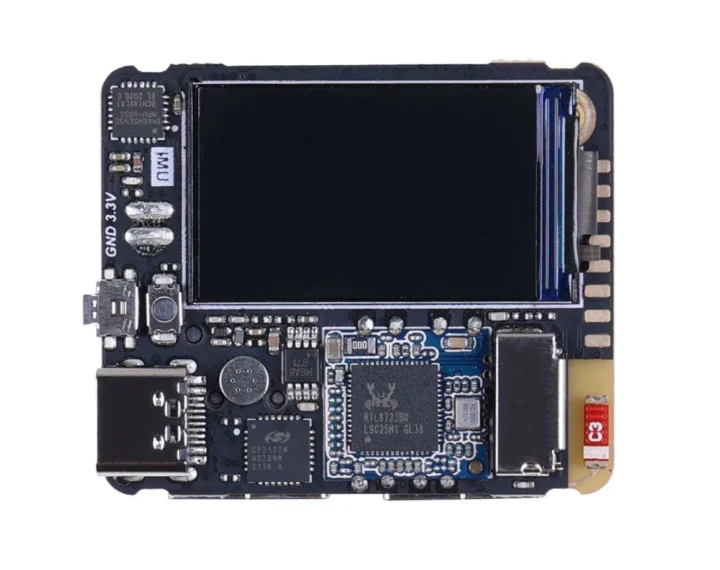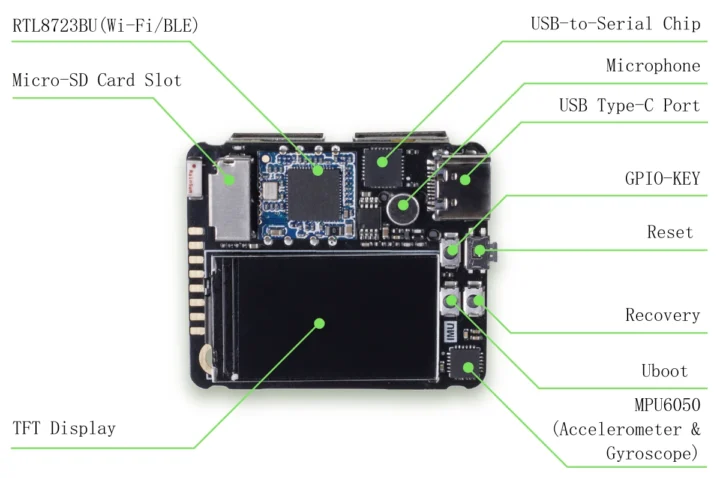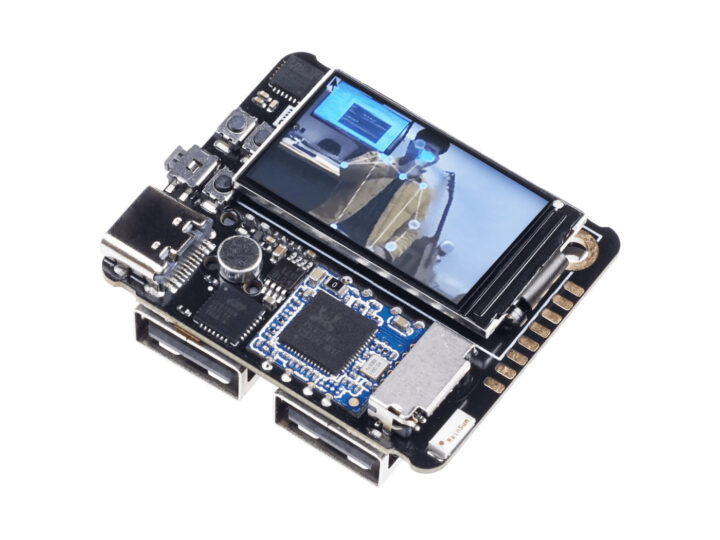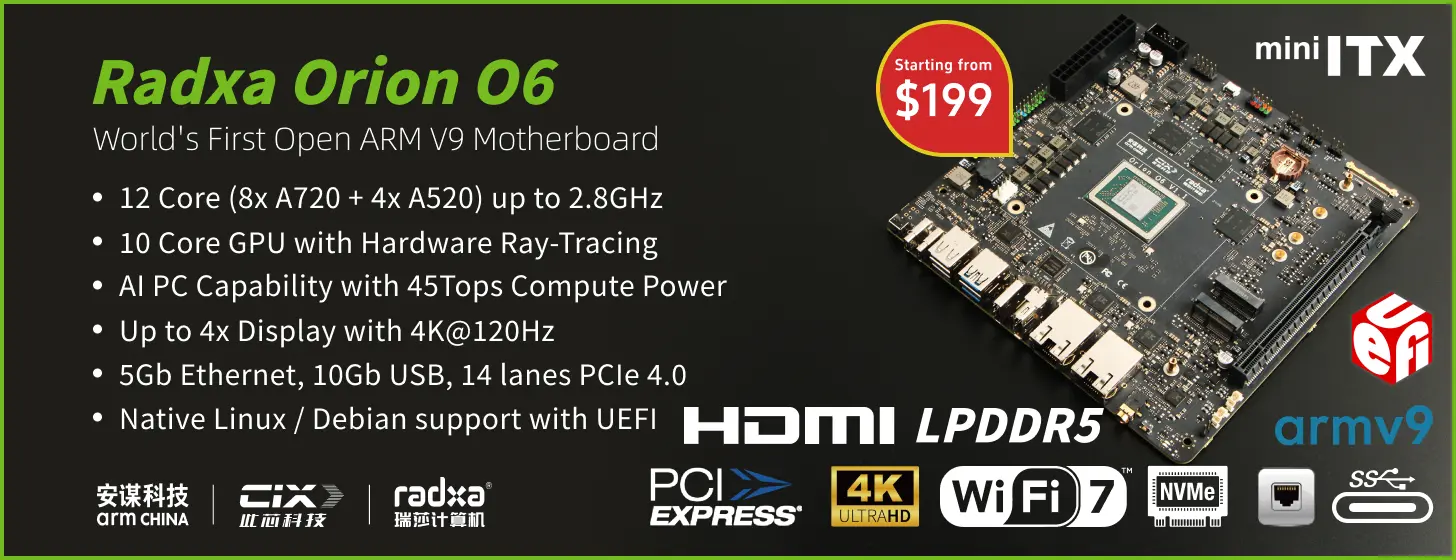Made by a Chinese engineer and content creator Zhihui Peng, the “Quantum Tiny Linux Development Kit” is a small SBC that’s smaller than an ID photo, powered by an Allwinner H3 SoC, and equipped with 512MB of RAM and a 16GB eMMC flash.
It’s a design with a 31x22mm CPU module with an M.2 edge connector and a 40x35mm carrier board with a microSD card slot, WiFi 4 and Bluetooth 4.0 wireless module, a TFT display, two USB 2.0 ports, a 6-axis motion sensor, and a few buttons.
Quantum Tiny specifications:
- Quark-N SoM
- SoC – Allwinner H3
- CPU – Quad-core Cortex-A7 @ 1GHz
- GPU – Arm Mali400 MP2 GPU
- System Memory – 512MB LPDDR3 RAM
- Storage – 16GB eMMC flash
- M.2 edge connector with Ethernet, SPI, I2C, UART, Reusable GPIO, MIC, LINEOUT
- Dimensions – 31 x 22mm (6-layer PCB)
- Temperature Range – 0 to 80°C
- SoC – Allwinner H3
- Atom-N Expansion Board
- M.2 socket for Quark-N system-on-module
- Storage – MicroSD card slot
- Display – TFT display
- Audio – Microphone
- Wireless – WiFi 4 and Bluetooth 4.0 via RealTek RTL8723BU module
- USB – 2x USB 2.0 ports, 1x USB Type-C port
- Sensor – MPU6050 motion sensor (gyroscope + accelerometer)
- Expansion – 8x pads with I2C, SPI, UART, ADC, GPIO, speaker, 5V, 3.3V, and GND
- Misc – 4x GPIO-KEY, Uboot, Recovery, and Reset buttons
- Power Supply – 5V via USB-C port
- Dimensions – 40 x 35mm


I’ve just realized the Quantum Mini was first introduced in 2020, and it has just resurfaced as people posted videos without many details, even failing to disclose the exact CPU… The Quantum Tiny looks to be an improved version with a different antenna type for better wireless performance, an optimized PCB layout moving the fan solder joints to the top, and without Uboot and Recovery buttons.
There was no documentation or OS image for it when I first wrote about the Mini in 2020, and the documentation has improved since then. The board runs a modified Linux image (Debian-based with apt package manager) made for FriendlyELEC’s Nano Pi M1 SBC that has not been updated since 2021… It can be used as a microcomputer, a personal website server, a voice assistant, a smart home hub, and for image processing and robotics applications. xRDP is also installed on the image, so you can also access the desktop remotely, even if it lacks an HDMI port.
The Allwinner H3 was first introduced in 2014 for TV boxes, and then found in many low-cost SBCs in the following years, so Linux mainline support should be quite good thanks to work by the sunxi-linux community. The 4-year-old video below shows the original prototype and some demos.
The Quantum Mini/Tiny board has been around for many years, but I don’t think it’s been overly popular. Some reasons are that there were also many low-cost Allwinner H3 SBCs on the market, and its feature set makes its $58 price tag unattractive (up from $49.90 in 2020).
Via Seeed Studio on X.

Jean-Luc started CNX Software in 2010 as a part-time endeavor, before quitting his job as a software engineering manager, and starting to write daily news, and reviews full time later in 2011.
Support CNX Software! Donate via cryptocurrencies, become a Patron on Patreon, or purchase goods on Amazon or Aliexpress. We also use affiliate links in articles to earn commissions if you make a purchase after clicking on those links.







Quite fun indeed, but unattractive pricing as you said.
I’ve had a Quantum mini SBCs for 3 or 4 years now and its great that its so small, but it gets very hot (burn hot), and also the screen is impractical outside. Like all these cool looking boards though I struggle to find a good use case for it as the power requirement requires a relatively large battery to make it practical. Low power modes are hard to program, and restoring from them adds huge latency. Software/OS and decent support is the next problem. Most of the time you’ll get a prebuilt OS/ukernel binary with god knows what in it (insecure), and there are always bugs in the drivers/HAL, meaning getting anything working requires active support, which is not the case with the Quantum since 2021. Shame though. Chinese documentation can also be a problem depending on how good the translation is.
I’m not surprised by the heating. I’ve used an H3 a decade ago on a bot, and it was indeed burning hot. I seem to remember that the later released H5 uses a better node and heats less while keeping the same pinout, but I could have mixed memory.